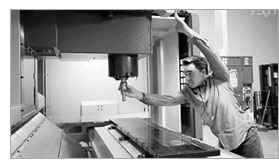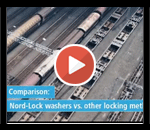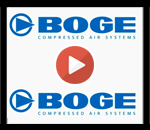CNC Machines – a completely digital designs, which eliminates the human intervention
Cutting tool manufacturers have worked together to create a generic tool catalog format that helps link cutting tool information with applications supporting data-driven manufacturing.
Computer Numerical Control (CNC) machines are automated milling devices that make industrial components without direct human assistance. They use coded instructions that are sent to an internal computer, which allows factories to fabricate parts accurately and quickly. There are many different types of CNC machines, ranging from drills to plasma cutters, so they can be used to make a wide variety of parts. Though most are used industrially in manufacturing, there are also hobby versions of most of the machines that can be used in private homes. CNC machines can have several axes of movement, and these movements can be either linear or rotary. Many machines have both types. Cutout machines like lasers or water jets generally have just two linear axes, X and Y. Milling machines usually have at least three, X, Y, and Z, and can have more rotary axes. A five axis milling machine is one that has three linear axes and two rotary, allowing the cutter to operate in a full 180º hemisphere and sometimes more. Five axis lasers exist as well. A robot arm might have more than five axes.

Types of CNC Machine
The most common CNC machines are milling machines, lathes, and grinders. Milling machines automatically cut materials, including metal, using a cutting spindle, which can move to different positions and depths as directed by the computer instructions. Lathes use automated tools that spin to shape material. They're commonly used to make very detailed cuts in symmetrical pieces, like cones and cylinders.
Grinders use a spinning wheel to grind down materials, and mold metal or plastic into the desired shape. They're easy to program, so they're usually used for projects that do not require the same precision as mills or lathes. Besides these, there are also CNC routers, which are used to make cuts in a variety of materials; as well as computer programmable 3D printers; and turret punches, which are used to make holes in metal or plastic. This technology can also be used with different types of cutters, including those that work with water, lasers, and plasma.
Programming and Operation
The code used to program CNC units is generically called G-Code. It contains information about where parts of the machine should be positioned, and tells the machine exactly where to place a tool. Other instructions tell the machine additional details, like the speed a part should run at; how deep it should cut, burn, or punch; and the angle of an automated tool. Most modern industrial CNC machines are tied into a network of computers, and receive operating and tooling instructions via a software file.
Advantages and Disadvantages
In an industrial setting, CNC machines can be combined into entire cells of tooling machines that can operate independently of each other. They are often driven by completely digital designs, which eliminates the need for design blueprints to be physically drawn up. Many are capable of running for several days without human intervention. In fact, some are so sophisticated that they can contact the operator’s cell phone and send an alert if a malfunction occurs. These automated features make it possible to produce thousands of parts with minimal supervision, and free the operator to perform other tasks.
Besides this, a CNC machine can form parts with a level of precision that is nearly impossible using older tools. In a conventional factory, workers must control different tools by hand, and errors are common, but a machine can perform the same task without becoming tired, and can work non-stop. This saves a lot of time, and the improved accuracy can help eliminate waste, since there are less faulty parts that have to be thrown away.
Despite their advantages, CNC machines are more expensive than older types of machines, which can make them unaffordable for smaller operations. They're also expensive to repair and maintain. Also, though they do limit the potential for errors, they don't eliminate it entirely, since operations can still program or operate the machine incorrectly. Additionally, these machines need to be operated by a skilled workforce with a specific type of training, which may not be available in all areas.
Development
CNC machines have evolved considerably since their initial introduction into the manufacturing industry. The earliest ones received code instructions through hard-wired controllers, which meant that the programming format could not be altered. Later models were programmed via mainframe cables and floppy disks, which permitted variations in programming.
CNC Machining is a process used in the manufacturing sector that involves the use of computers to control machine tools. Tools that can be controlled in this manner include lathes, mills, routers and grinders. The CNC in CNC Machining stands for Computer Numerical Control.
Under CNC Machining, machine tools function through numerical control. A computer program is customized for an object and the machines are programmed with CNC machining language (called G-code) that essentially controls all features like feed rate, coordination, location and speeds. With CNC machining, the computer can control exact positioning and velocity. CNC machining is used in manufacturing both metal and plastic parts.
First a CAD drawing is created (either 2D or 3D), and then a code is created that the CNC machine will understand. The program is loaded and finally an operator runs a test of the program to ensure there are no problems. This trial run is referred to as "cutting air" and it is an important step because any mistake with speed and tool position could result in a scraped part or a damaged machine.
There are many advantages to using CNC Machining. The process is more precise than manual machining, and can be repeated in exactly the same manner over and over again. Because of the precision possible with CNC Machining, this process can produce complex shapes that would be almost impossible to achieve with manual machining. CNC Machining is used in the production of many complex three-dimensional shapes. It is because of these qualities that CNC Machining is used in jobs that need a high level of precision or very repetitive tasks.
CNC machines can be used continuously 24 hours a day, 365 days a year and only need to be switched off for occasional maintenance.
CNC machines are programmed with a design which can then be manufactured hundreds or even thousands of times. Each manufactured product will be exactly the same.
Less skilled/trained people can operate CNCs unlike manual lathes / milling machines etc.. which need skilled engineers.
CNC machines can be updated by improving the software used to drive the machines.
Modern design software allows the designer to simulate the manufacture of his/her idea. There is no need to make a prototype or a model. This saves time and money.
One person can supervise many CNC machines as once they are programmed they can usually be left to work by themselves. Sometimes only the cutting tools need replacing occasionally.
A skilled engineer can make the same component many times. However, if each component is carefully studied, each one will vary slightly. A CNC machine will manufacture each component as an exact match
Some limitations of CNC controlled machines
Depending on their age and sophistication, CNC machines can be limited to the capabilities of their control and drive systems. Most CNC controllers only understand straight line movements and circular arcs. In many machines, the arcs are restricted to the principal XYZ planes as well. Rotary axis movements can be considered like linear movements, just degrees instead of distance.
The speed at which the machine controller can receive and process the incoming data, transmit commands to the drive system, and monitor the machine’s speed and position is critical. Older and less expensive machines are obviously less capable in this, much in the same way that an older computer will work less well and more slowly (if at all) on demanding tasks than a newer one.
Interpret 3D and spline data first
A typical problem is how to set up files and do CAM programming so that the machine executing parts will work smoothly and efficiently with the data. Since most CNC controls only understand arcs and lines, any form that is not describable with these entities needs to be converted into something usable. Typical things that need converting are splines, i.e. general NURBS curves that are not arcs or lines, and 3D surfaces. Some desktop machine systems are not able to understand circular arcs either, so everything must be converted into polylines.

























 Facebook
Facebook Plus Google
Plus Google Linkedin
Linkedin Twitter
Twitter